Engaging learners is crucial for effective learning experiences. Getting learners into your class is one thing, but how do you keep them engaged once they are in there? By implementing learner engagement strategies, learning leaders and practitioners can create a more interactive and dynamic learning environment.
In this article, we'll explore five tips that we've found in common with the most successful virtual learning programs.
Strategy #1 - Make Learning Experience Designs Look and Feel Different
It’s fairly common practice in learning and development (L&D) to templatize things for the sake of efficiency, but be careful about making everything look the same. When everything looks the same, nothing feels new and exciting – it just blends in. Engagement benefits the things that stand out!
Give your class personality by using a new style and visual design for virtual learning. Incorporate new homepage images, use different font formatting, and break up long text with graphics, interactive elements and multimedia content. Even if you have corporate branding guidelines to stick to, it’s possible to be compliant while differentiating pages with a visual variety.
 2023 Intrepid Momentum Award Winner for Best Visual Design
2023 Intrepid Momentum Award Winner for Best Visual Design
Another thing you can do to make it feel different is try and avoid corporate speak and jargon as much as you can and instead use a more conversational tone in your content. We're bombarded with corporate speak all day long, but it's not how we communicate in general and not something people connect with. A conversational tone can help you connect to your learners more and makes content easier to read.
Strategy #2 - Use Activities in Learning Content to Tap into Emotions
Emotions play a big role in learning. One of the best ways to evoke engagement in learning is to use activities that connect with emotions in the form of collaborative learning. Collaborative learning activities can range from interactive quizzes, gamification, group discussions, and applied learning exercises.
For example, use discussion prompts that require learners to tap into some sort of emotion, such as “Tell us about a time when you had to challenge the way things have always been done,” “What would you do differently?,” or “Reflect on a time when you had a challenging coaching conversation.”
Each of these examples asks people to tap into experiences where they most likely felt strong emotions that make interesting stories. People enjoy reading reflections they can connect with, as well as sharing their knowledge and expertise. You just have to create a safe place to share and ask the right questions to entice them to want to share
Like marketers, we can appeal to basic emotions like surprise, joy, or fear to grab people’s attention. But once they are committed to learning, focus on “academic emotions” like confusion, frustration or boredom — or, better yet, curiosity, delight and flow.
Using activities to connect with emotions will help learners to engage with the material on a deeper level and remember what they’ve learned. Plus, it can be a fun way to engage with and learn from others.
Strategy #3 - Recognize Positive Learning Behaviors
We're often quick to send out emails to remind people of negative learning behaviors, like "You have two learning items that are overdue. Please complete them as soon as possible." Or, "We noticed you haven't logged in this week. Please log in and complete this week's assignments." These are helpful nudges, but what if you also sent some communications that recognized the positive work people are doing, too?
It's always nice to be recognized for our hard work and dedication. Be sure to recognize and celebrate the contributions of your learners. They aren’t taking your class to just post their thoughts into the void of the internet. They appreciate knowing their contributions are being seen and have value.
So, when you see learners making posts that demonstrate positive learning behaviors, recognize them! It could be a comment on their post, giving certificates or badges for achievements, including their post in a highlight email, or acknowledging them in an announcement. Acknowledging those who are putting in the work helps reinforce their participation and also encourages others to do more as well!
 This email highlights some of the best posts of the week and provides links back to the class to give people easy access to check it out themselves.
This email highlights some of the best posts of the week and provides links back to the class to give people easy access to check it out themselves.
When people are engaged, recognized, and finding value in your learning programs, you may find you are spending less time looking at reports of people who haven't logged in, and more time trying to decide which learners and posts to highlight!
Strategy #4 - Actively Participate in the Learning Experience
It’s easy to feel like online learning is a set it and forget it type of thing, and parts of it can be. But if you really want to increase engagement in a collaborative learning environment and create a sense of community, then you need an active moderator that’s involved in the training program. This can be done by monitoring discussions and submissions, responding to comments, answering questions, offering feedback, and/or connecting people together.
 Make learners feel welcome and use moderators to connect them with information
Make learners feel welcome and use moderators to connect them with information
And in large classes, you don’t have to reply to every single post - think quality of responses over quantity. Your presence lets people know this isn’t a faceless program and that there are people actually reading and responding to posts. Just like above where you recognize learners' positive behaviors, learners will recognize your behavior as well and feel more connected and motivated to engage with the material.
Strategy #5 - Nudge People During the Learning Process
“If you build it, they will come” doesn’t apply to workplace learning. If you build it, they still have meetings, projects, deadlines, and life happening, so they might need some nudges from time to time to get back into class. And there are ways to do it that don’t really feel like nudges:
- Use a beginning of the week email to let learners know new material is available (gentle nudge)
- Use a mid-week highlight email to showcase some of the best posts learners have shared so far (another gentle nudge)
- Use a “we miss you” email for folks who haven’t logged in during the week to let them know you’re aware of their activity (strong nudge)
Gentle nudges entice the learner to click and log back into the class by sharing new, engaging information with them, such as letting them know new content has been released or sharing what other people are posting. Strong nudges add a little bit of accountability by letting the learner know we have noticed they haven’t logged in at all.
 When gentle nudges don't work, add a little personal accountability with a stronger nudge
When gentle nudges don't work, add a little personal accountability with a stronger nudge
Your communications are like a piece of content, so you should treat them like one. Make them stand out from the rest of the emails in learners' inboxes and make them want to click back into your class. We've found that each of these nudges results in roughly a 20% click back into the class, so that's 20% more people returning to your class with each nudge! The more people you get into the class and participating, the more you’re increasing learner engagement rates.
Summary
When we look at the most successful, engaged classes, these are the five learner engagement strategies they all have in common:
- Look/feel different than the average workplace learning
- Tap into emotions
- Recognize positive behaviors
- Have admins/moderators/instructors involved in the class
- Have a communication plan to nudge people back in
We hope this helps give you some inspiration to boost motivation and learner engagement in your learning and development initiatives! If you’d like to learn more about how collaborative learning is being used by high-performing organizations to achieve 52% better engagement, download our white paper, “Collaborative Learning: The Key to Better Performance.”
Frequently Asked Questions About Learner Engagement
What is learner engagement?
Learner engagement is the level of involvement, interest, and active participation that learners demonstrate during the learning process.
What are learner engagement strategies?
Five effective learner engagement strategies in the workplace include:
- Making learning experiences look and feel different
- Using activities tap into emotions
- Recognizing positive learning behavior
- Having instructors/moderators actively participate
- Nudging people during the learning process
What is an example of learner engagement in the workplace?
An example of learner engagement in the workplace is through a group discussion or hands-on activity related to a specific topic or skill. During the discussion or activity, learners actively contribute their ideas, ask questions, and collaborate with peers. This example illustrates learner engagement through active participation, interaction, and applied learning.
false LOREM IPSUM TITLE





 Previous
Previous
